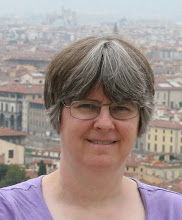Candles and the Idea of the Holy
.jpg) There's a sense of the sacred in this photo, even though I personally don't find connection with the Almighty through lighting candles in a stone church. Or at least I didn't used to. I'm beginning to be able to relate to that. I used to find the practice "too Catholic" (paying for candles to light in the church smacked too much of indulgences; is God supposed to be more likely to answer my prayer if I send it up with a candle?) But now there are many things I appreciate about the Catholic way of worship that I didn't understand before. Lighting candles in prayer isn't necessarily a biblical practice, but lampstands were definitely used in worship (e.g., Exodus 25, 37; Zechariah 4; Revelation 1-2). And there's the "smoke of the incense, together with the prayers of the saints" which "went up before God" in Rev 8:4. Candlelight vigils are held by many of various faiths, including Christians, in the event of a great tragedy. There is something about a lit candle that helps people focus their attention on God. A friend of mine who is a spiritual director always lights a candle before she starts her sessions, and leaves it burning throughout the hour, to remind both herself and the directee that God is present with them and it is really God who is the Director. I have now experienced lighting candles for prayer in several different settings. I've done it in a Taizé worship service, in a Greek Orthodox Good Friday service, online, and I've even done it in my own home in front of...gasp!...an icon! I am less quick to judge the spiritual practices of others now than when I was younger.
There's a sense of the sacred in this photo, even though I personally don't find connection with the Almighty through lighting candles in a stone church. Or at least I didn't used to. I'm beginning to be able to relate to that. I used to find the practice "too Catholic" (paying for candles to light in the church smacked too much of indulgences; is God supposed to be more likely to answer my prayer if I send it up with a candle?) But now there are many things I appreciate about the Catholic way of worship that I didn't understand before. Lighting candles in prayer isn't necessarily a biblical practice, but lampstands were definitely used in worship (e.g., Exodus 25, 37; Zechariah 4; Revelation 1-2). And there's the "smoke of the incense, together with the prayers of the saints" which "went up before God" in Rev 8:4. Candlelight vigils are held by many of various faiths, including Christians, in the event of a great tragedy. There is something about a lit candle that helps people focus their attention on God. A friend of mine who is a spiritual director always lights a candle before she starts her sessions, and leaves it burning throughout the hour, to remind both herself and the directee that God is present with them and it is really God who is the Director. I have now experienced lighting candles for prayer in several different settings. I've done it in a Taizé worship service, in a Greek Orthodox Good Friday service, online, and I've even done it in my own home in front of...gasp!...an icon! I am less quick to judge the spiritual practices of others now than when I was younger.
(*) The title of this post, by the way, comes from the book The Idea of the Holy by Rudolf Otto, in which he coined the term "numinous" - that which is holy, awesome, "wholly other" about God; that which transcends rational comprehension.

.jpg)
.jpg)



